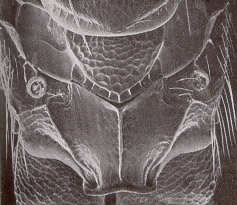
1a-b: Dicladocerus epinotiae Yoshimoto mesosoma (left), and D. nearcticus Yoshimoto propodeum (right)
return to: Eul 1 Eul 4 ent 1 eud 1 cir1 eul 1 eul 5 eul 10 eul 14 eul 17 eul 20 eul 24 eul 27
Dicladocerus Westwood, 1832 comparative
info return to: prev(eul 22) prev(eul 32) home
Flagellar formula 2,3,3 in females, 1,4,2 in males; flagellum with 2
branches in males (on basal pair of postanellar flagellomeres). Notauli
incomplete or ending in anterior half of axilla far from scutellar margin; mesoscutal
midlobe setae paired or indistinct; scutellum almost always with straight,
parallel submedian grooves indicated by change in sculpture,
sometimes indistinct. Postmarginal vein longer than stigmal vein, sometimes >2x stigmal
vein length, shorter than marginal vein; uncus arising more than its own length
from apex of stigmal vein. Propodeum with median carina and complete or
incomplete plicae that are frequently raised, 'step-like' in that they separate raised
median panels from the sunken paraspiracular area of the propodeum. Compare with: Necremnus,
Notanisomorphella.

1a-b: Dicladocerus epinotiae Yoshimoto mesosoma (left), and D.
nearcticus Yoshimoto propodeum (right)
2a-b: Dicladocerus forewing (left), and male antenna (right)
Biology: Parasitoids of Lepidoptera.
Comments: 19 described species. Males not confusable with any other genus if the antennae are present and undamaged. Females may be very difficult to identify to genus if the submedian scutellar grooves are not apparent, and can resemble a Necremnus with a too-long, too-developed propodeum and elongate stigma.
Comparative information:
Necremnus (females): Scutellum without submedian grooves. Propodeum usually without plicae. Postmarginal vein at most 1.7x stigmal vein length, uncus rarely arising distinctly more than its own length from apex of stigmal vein [known exceptions: N. metalarus (Walker)]. All female Dicladocerus that I am aware of with faint submedian scutellar grooves have plicae or plical ridges delimiting median panels that are slightly to sharply raised above the lateral areas of the propodeum, and in nearly all species of Dicladocerus the uncus is separated from the stigmal apex by more than its own length. Necremnus propodealis Boucek is notable as a species of Necremnus with a strong median carina and step-like plicae, but in that species the uncus is separated by its own length from the stigmal apex. This still leaves a few species of Dicladocerus in which females cannot be separated from Necremnus females. This problem is compounded by the fact that some Necremnus specimens have very faint submedian scutellar grooves. Separation of these two poorly known genera is problematic, and cannot be fully accomplished at this time.
Notanisomorphella: Flagellum with 4 funicular segments. Males with 3 antennal branches. Never with longitudinal scutellar grooves. Uncus arising about its own length from stigmal apex.
References
Graham, M.W.R. de V. 1963. Additions and corrections to the British list of Eulophidae (Hym., Chalcidoidea). Transactions of the Society for British Entomology. 15(9): 167-275.
Yoshimoto, C. 1976. Revision of the genus Dicladocerus (Eulophidae: Chalcidoidea) of America north of Mexico, with particular reference to species attacking larch casebearer (Lepidoptera: Coleophoridae). Canadian Entomologist. 108: 1173-1206.
Image credits: 1a-b, 2a: Yoshimoto (1976). 2b: Graham (1963).